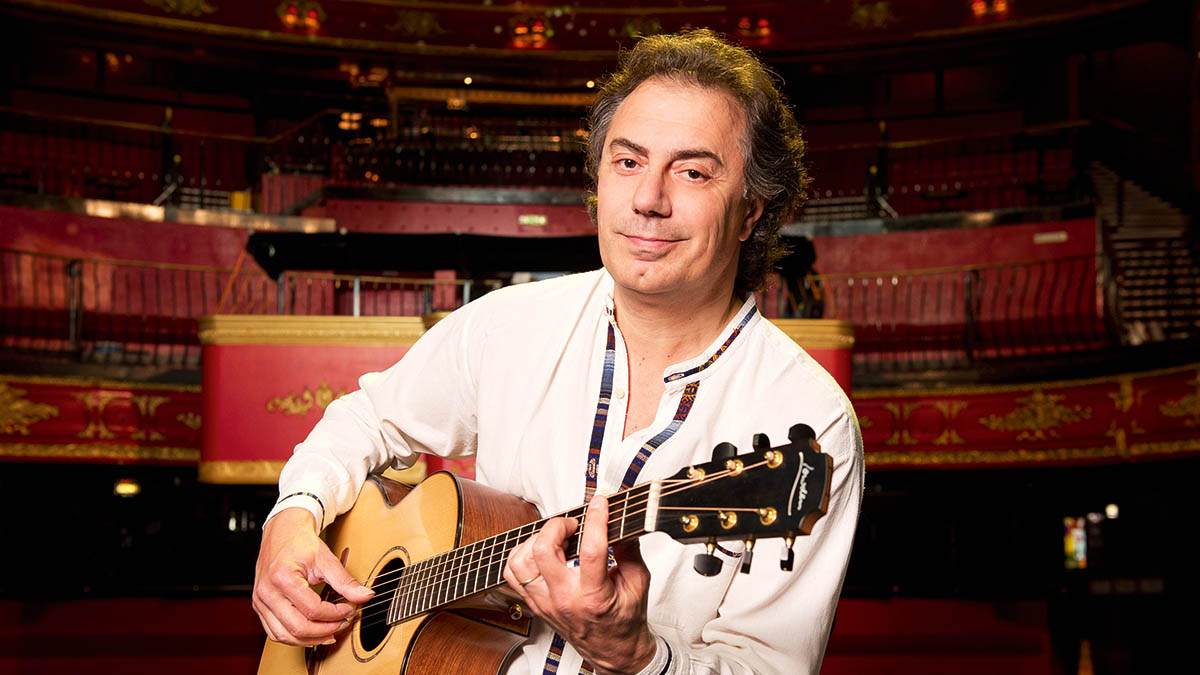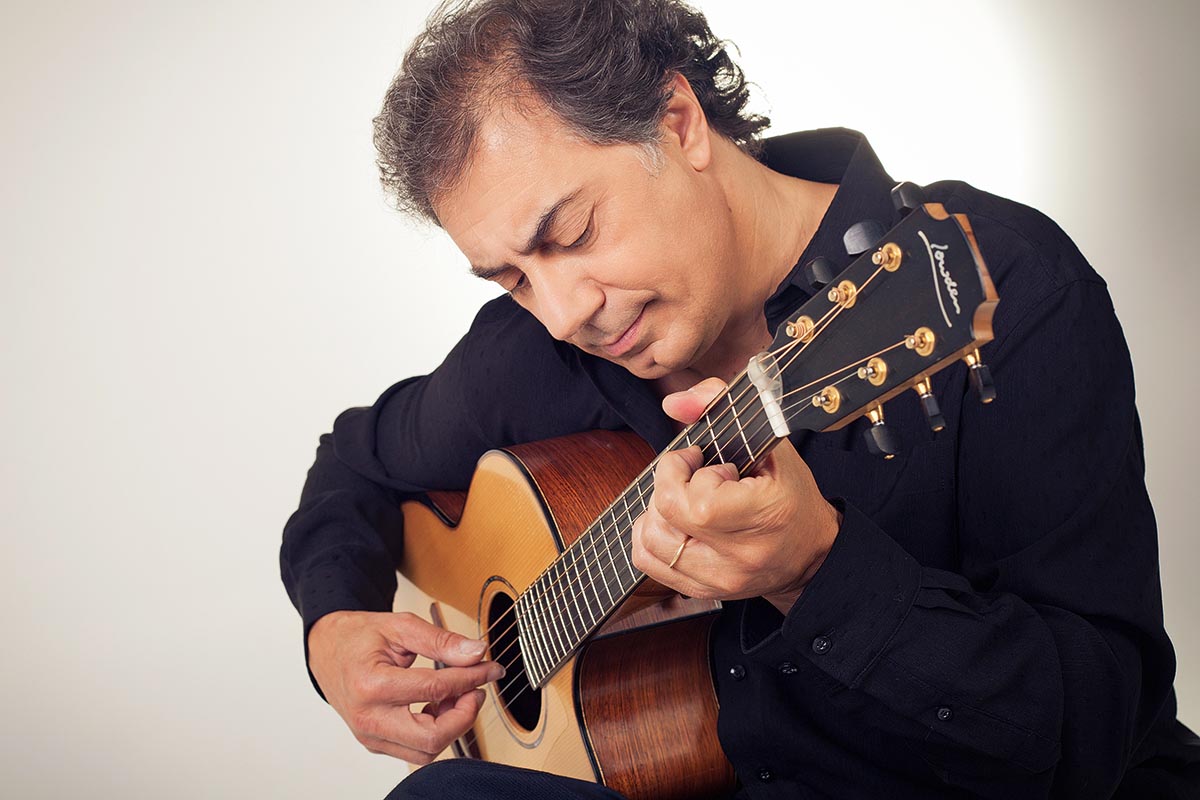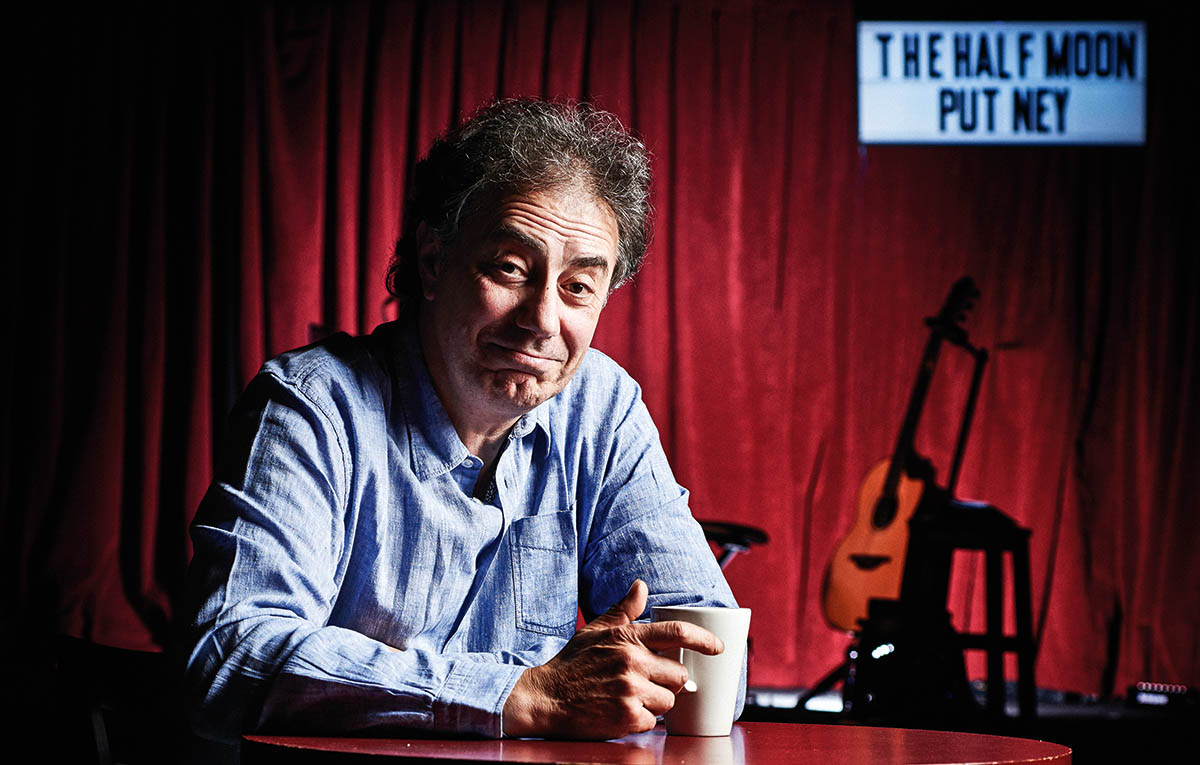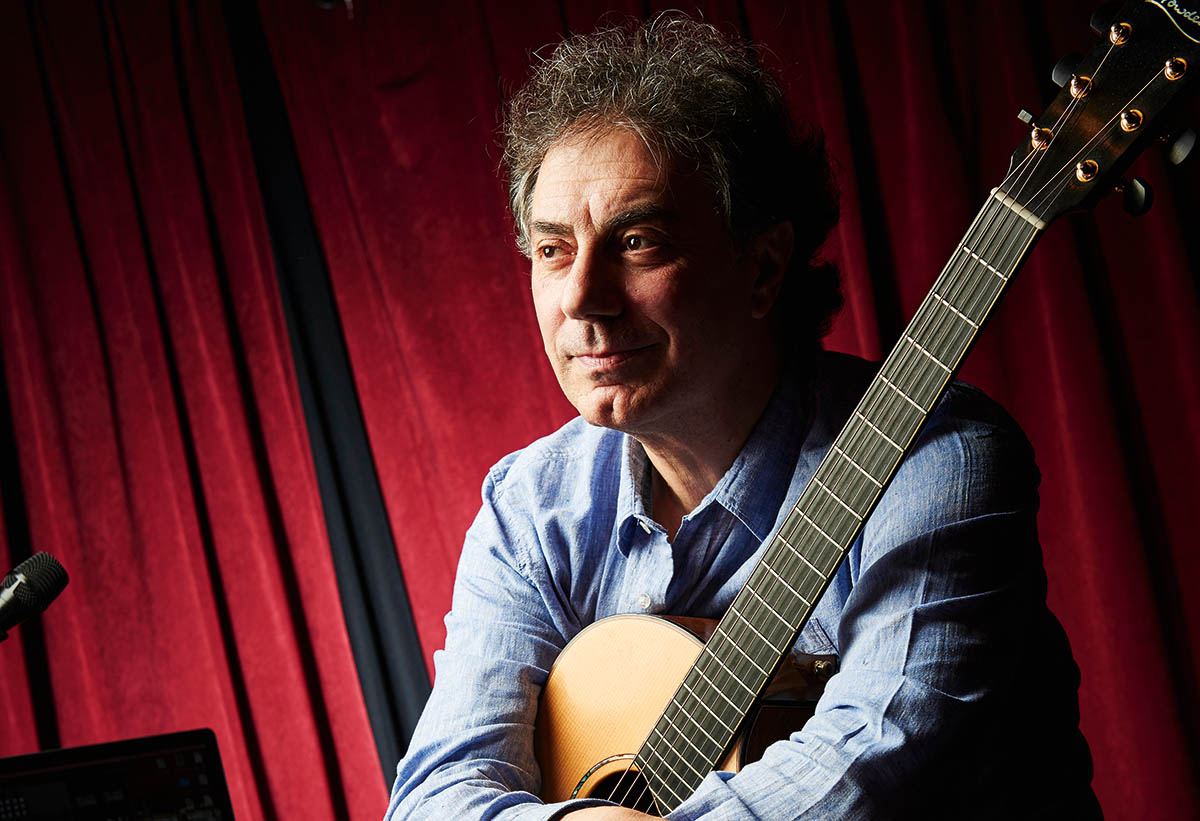Pierre Bensusan: “The way you tune the strings should not be used to hide a possible lack of imagination, but it should enhance it“
The French-Algerian DADGAD maestro on letting inspiration find him for new record Azwan – an album inspired by bees

Just before the world fully felt the impact of lockdown in 2020, Pierre Bensusan released a new album, Azwan, and embarked on a US tour to promote it. These best-laid plans were soon scuppered and Pierre was forced to make the dash back to France to rethink the immediate future.
While few people are yet to hear it live, this album remains his best for years, with intense and evocative compositions delivered with a remarkable level of finesse.
Tell us about the concept of the album…
“The concept of Azwan came from observing bees, those solar insects working in the darkness together as one, and by observing flocks of birds flying and dancing together as one. It has been an inspiring symbolic representation of the continuum of music.
“When seeing Azwan written, it can evoke a place, a city or a mood, but when hearing it said out loud, it sounds like ‘as one’. I’ve been contemplating all the music from Azwan for years before actually recording it, taking time to allow all the notes to come together, as one.”
Your latest book, the dual-language Pierre Bensusan Guitar Collection, not only draws upon your latest album but also includes some pieces from your live repertoire, too. How did it come about?
“I’ve had this book in mind for a while. It was meant to be a collection of scores from the new album, but my Chinese publisher suggested I should include some pedagogical approaches. He also wanted to see a selection of pieces that are played at concerts, where the renditions could be different from the original versions.
Get The Pick Newsletter
All the latest guitar news, interviews, lessons, reviews, deals and more, direct to your inbox!
“On the other hand, my manager in England, Dave Bevan, was expecting an introspective book about DADGAD. In the meantime, I released DADGAD Explorer with the US company TrueFire. This is an instructional DVD, which deals with my approach to practising and playing the guitar, as seen through the prism of DADGAD.
“Since The Guitar Book, published by Hal Leonard in 1986, I’ve had plenty of time to revisit my path, to put some of my thoughts down on paper. After 40 years of touring, giving residential seminars, private lessons, masterclasses and workshops, I’m looking forward to presenting this collection of 18 pieces, complemented by a comprehensive glossary and additional topics.
“I hope this book will be the new companion for people who follow my work. Since every tune in this collection illustrates, in its own way, how the tuning opens up to chords, counterpoint, melody and lead lines, I encourage people to feel free to transform any excerpt into an exercise or a study.”

These releases came during an unprecedented time. How have you been affected since the pandemic hit?
“[Having spent] the last few years off the concert trail in order to meticulously craft the new album, which was to be supported by an extensive 110-date US and Canadian concert tour running from March into July, I suddenly found myself back home on French soil after having to pull the plug three weeks into the concert trek. The entire tour is being rebooked for 2022.
“Once home and on lockdown, I took advantage of all that time and it allowed me to do many things I never had the time to do before. I played a lot and wrote several new pieces.
“My wife and I live in the country in an old stone house with a garden, so we were locked down in paradise, so to speak – we are very lucky. The other side of this crisis is very freaky, and I fear the world afterwards might be even worse than the world before. But if we are smart, we might learn something from this mess.
“As time goes on, the more I feel connected to all people, to the animal kingdom and universally to the whole of nature. Being that we are all connected, my intention is that every action and behaviour contributes, supports and adds value to our interconnectivity, especially through music. It feels like a nurturing or even a healing process for me and those with whom I share music. In that sense, maybe the album could have not come at a better time.”

Can you share with us how you first encountered DADGAD tuning?
“When I was 15, I lived in Brittany and busked around cafes and restaurants. I had time to play and experiment with different ways to tune – and DADGAD revealed itself to me this way. I had never heard of Davey Graham at that point. I then went to the Kertalg Festival, which was two hours away, and discovered the Irish band Planxty.
“It was here that I had the revelation that this tuning – I didn’t know it was called DADGAD at the time – was perfect for playing and rearranging Celtic music, as I did for my first three albums. From 1978, I chose it as my only tuning and started to study the guitar in a more serious way from then on.”
For me, DADGAD is my native tuning, exactly as standard tuning would be for players who have spent the last 40 years or so playing in one tuning
Some players complain that DADGAD traps them into playing in the key of D all the time…
“I’m not surprised. It’s not only very jubilant, but it’s also addictive. I think the best way to avoid being trapped is to dive in and explore the tuning – then you can choose if you prefer to noodle around and sound like everyone else or really express yourself. You don’t want the tuning to be playing you, but the other way around!
“The way you tune the strings should not be used to hide a possible lack of imagination, but it should enhance it and help you get to new ground, or old ground in a different way. Ultimately, the goal is to know your fretboard as you know your home, the neck being the tarmac from which you take off and land.
“For me, DADGAD is my native tuning, exactly as standard tuning would be for players who have spent the last 40 years or so playing in one tuning. I study it the same way – harmony, scales and modes, relationships to the open strings, harp effect, counterpoint, nuances and expression.
“Distribution of the notes on the strings and frets, unconventional techniques, ornamentation and slurs give my right hand all the power, vocabulary and versatility it needs, so the articulation and tone are as clear, beautiful, contrasting, sensual and as evocative as could be.”
What advice would you give to players when it comes to seeking out inspiration?
“Be true to yourself. In order to get there do not hesitate to put yourself in a bubble and stop listening to what people say, think, write, comment, criticise, play, come up with, etc. You have to isolate and protect your secret garden to follow your path and dive deep into your imagination. Make your voice unique and use it to heal you, embellish your life and the world you live in.”
Is improvisation still an important part of your writing process?
“It’s a different process for each track, but their common point is they have all been initiated by improvisation. Then I let them incubate for months – or even decades – before I turn my attention to them and start writing and arranging the music for guitar. Sometimes I will play and write, and other times I will just sing what I hear and write the notes into Sibelius [music software], which transforms them into tablature. Then I work out the fingering and string arrangements from there.
“For instance, I dreamed Azwan, the title track of the album, and was lucky enough to remember it once I woke up. I immediately went and recorded it on my phone and then forgot it and found it again months later. I took it into my ‘internal hard drive’ and started to compose it, thinking about the places and perspectives it could reach.
“With such a repetitive motive, the main focus was to find a form and give it an expansive movement. It starts with a straightforward, hummable melody, then develops, then soars, then lands. A novelist has pretty much finished their work once the book is written, but composing music is only half of the process – the other half is to play it and find the means to interpret it so that the music speaks.”
Did you use your Lowden ‘Old Lady’ for the album?
“Yes, I did. I’ve been fascinated by the way this guitar has developed since 1978. Every time I play it it’s like coming home. The sound itself disappears behind the music. Of course, George Lowden and I have known and worked together since then and have become close friends. George’s spirit is in my guitars – I always say it’s ‘a story with four hands’.”
Nothing can replace an audience and I have been asked many times, since we’ve entered into this new world, to do a streaming concert alone in front of a camera, but that’s not in my DNA
Do you enjoy being in the studio?
“I love being in a recording studio, especially when it’s in my home, because I can stop, start again, record over 30 minutes or an hour of music and pick out the best moments. It’s very different to playing a live concert – the energy is completely different. Nothing can replace an audience and I have been asked many times, since we’ve entered into this new world, to do a streaming concert alone in front of a camera, but that’s not in my DNA, at least for now. But if this situation lasts, I guess I’ll have to adapt.”

What’s your mic setup in the studio?
“For the guitar, I use two microphones: a Tube CAD that’s plugged into a PAL Tube Preamp by Requisite Audio, and a CharterOak condenser mic plugged into GML 2020 preamp, plus my LR Baggs VTC pickup that’s going into a germanium preamp by Chandler. For the vocals, I use my second Tube CAD plugged into another PAL Tube preamp. My tracking room is small, so there’s no need for a stereo mic pair to capture the ambience.”
How do you feel about playing live, when it becomes possible again?
“To be honest, playing live seems to belong to a different part of my life. With this pandemic I feel there is a before and after. I’m not sure what playing live will be like in the future or when we’ll get there again. Hopefully very soon.
“I just know that I need the stage, not only because it’s how I make my living, but because it has always been my means and motivation to embody the musician I aspire to be. I need to confront the music with the public and give it all to the audience. Meanwhile, I promise to keep my heart and learn to shed the light in other ways…”
- Azwan is out now via DADGAD.
With over 30 years’ experience writing for guitar magazines, including at one time occupying the role of editor for Guitarist and Guitar Techniques, David is also the best-selling author of a number of guitar books for Sanctuary Publishing, Music Sales, Mel Bay and Hal Leonard. As a player he has performed with blues sax legend Dick Heckstall-Smith, played rock ’n’ roll in Marty Wilde’s band, duetted with Martin Taylor and taken part in charity gigs backing Gary Moore, Bernie Marsden and Robbie McIntosh, among others. An avid composer of acoustic guitar instrumentals, he has released two acclaimed albums, Nocturnal and Arboretum.
“I knew the spirit of the Alice Cooper group was back – what we were making was very much an album that could’ve been in the '70s”: Original Alice Cooper lineup reunites after more than 50 years – and announces brand-new album
“Such a rare piece”: Dave Navarro has chosen the guitar he’s using to record his first post-Jane’s Addiction material – and it’s a historic build





![[from left] George Harrison with his Gretsch Country Gentleman, Norman Harris of Norman's Rare Guitars holds a gold-top Les Paul, John Fogerty with his legendary 1969 Rickenbacker](https://cdn.mos.cms.futurecdn.net/TuH3nuhn9etqjdn5sy4ntW.jpg)





